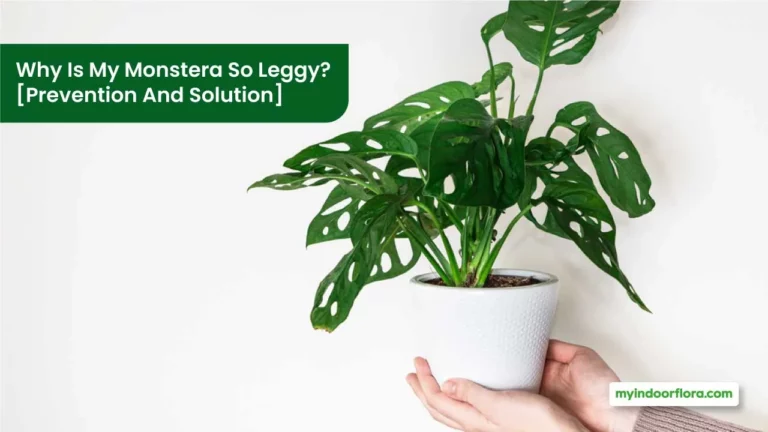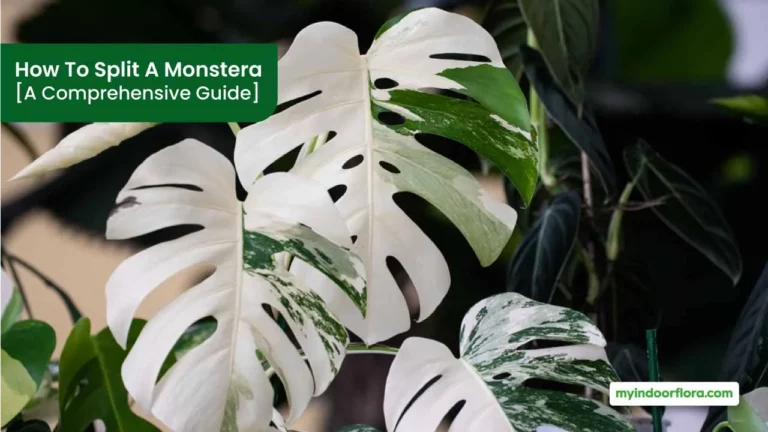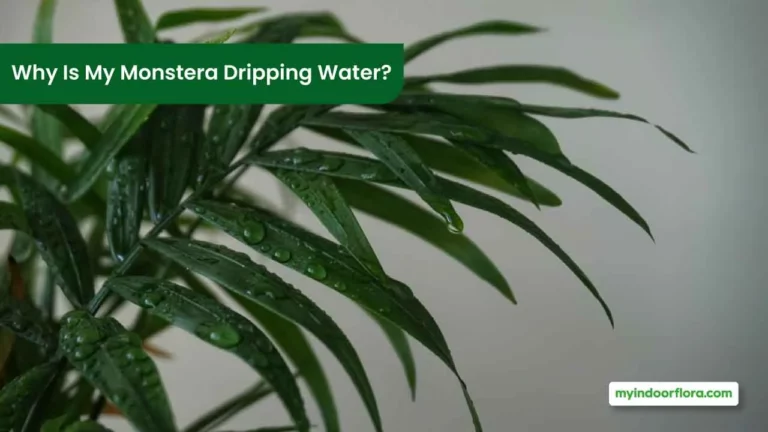Monstera, scientifically known as Monstera Deliciosa, is a tropical plant indigenous to Central America. Renowned for its unique, split leaves and rapid growth, it is a prime choice for indoor garden enthusiasts globally. A study from the Botanical Society of America cited this species as one of the most sought-after indoor plants in the past decade, thanks to its aesthetic appeal and easy maintenance.
Staking a Monstera refers to the process of providing external support, ensuring its optimal growth and health. At its core, staking allows the plant to mimic its natural climbing behavior, typically observed in the dense forests of Central America. When aptly supported, Monsteras not only stand tall but also exhibit an enhanced rate of growth and healthier leaf development.
Navigating through this article, you’ll uncover the nuances of why Monsteras need staking, the tools required, and a comprehensive guide on the staking procedure. With detailed insights and actionable tips, prepare to unlock the true potential of your Monstera and foster its majestic stature.
Why Monstera Plants Need Support
Monsteras, like many tropical rainforest plants, have evolved in environments where they frequently climb trees or other structures to access sunlight. This behavior isn’t just a byproduct of their environment; it’s an inherent growth pattern that’s been hardwired into their DNA.
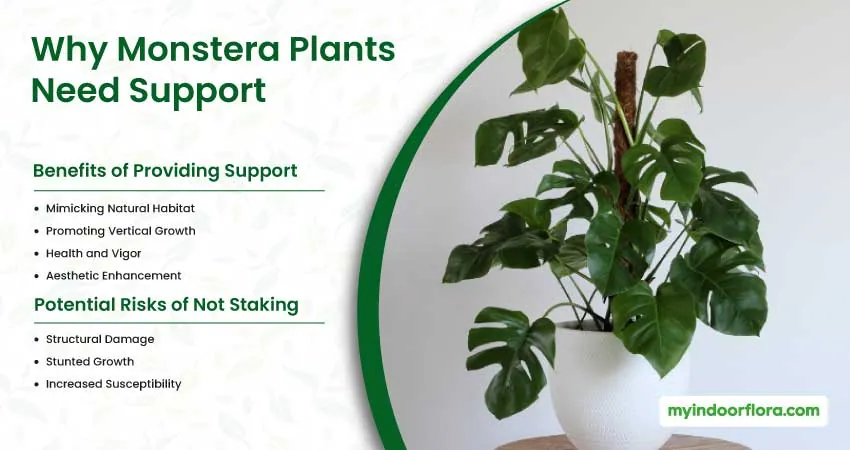
Benefits of Providing Support
- Mimicking Natural Habitat: In the dense rainforests, young Monsteras start their life on the forest floor. As they mature, they tend to climb up trees, leveraging them for support and light. By staking your Monstera, you replicate this natural growth process.
- Promoting Vertical Growth: Monsteras can sprawl, taking up more space than some plant owners might anticipate. Staking ensures they grow vertically, reducing their footprint and ensuring they don’t smother other plants nearby.
- Health and Vigor: Staked plants can redirect energy from supporting their weight to growth and fruiting. A 2019 research study from Plant Physiology Journal found that supported plants often exhibit healthier leaf development and better resistance to certain pests.
- Aesthetic Enhancement: A well-staked Monstera can be a visual delight. Its sprawling leaves, when given vertical dimension, can turn into a beautiful green spiral, capturing the attention of anyone in the room.
Potential Risks of Not Staking
- Structural Damage: Monsteras, without proper support, can become top-heavy, leading to them toppling over. This can cause physical damage to the plant and the pot it resides in.
- Stunted Growth: The stress of bearing its own weight can lead Monsteras to exhibit stunted growth or even start shedding leaves.
- Increased Susceptibility: Unsupported Monsteras might be more prone to pests as their leaves rest on the soil, promoting conditions for soil-based pests to transfer.
Choosing the Right Stake for Your Monstera
The right stake can make a significant difference. While the purpose remains the same—providing support—different stakes offer varying benefits.
Wooden Stakes
A popular choice for many, primarily due to its natural look that seamlessly blends with the plant.
Pros:
- Aesthetically pleasing
- Easily available and affordable
Cons:
- Susceptible to rot over time
- Might need replacement after a couple of years
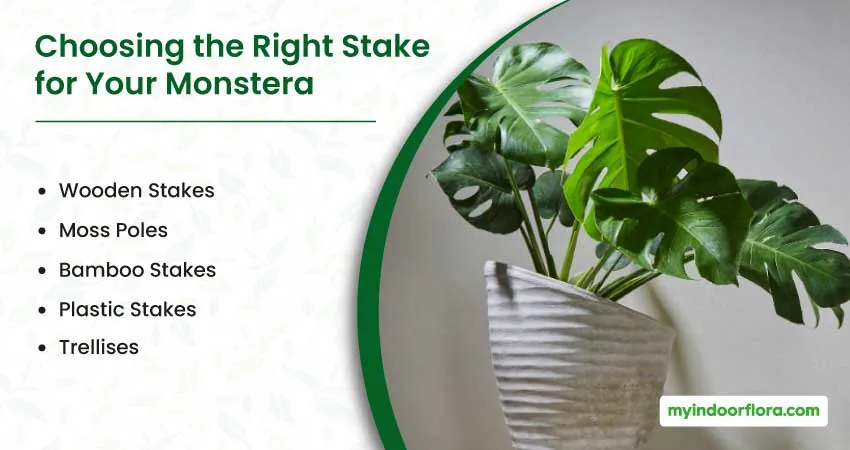
Moss Poles
A moss pole is not just a support structure; it’s also a medium for the aerial roots to grasp onto.
Pros:
- Maintains moisture, aiding in humidity regulation, a factor the Monstera loves.
- The rough texture promotes better adherence for the plant.
Cons:
- Can be pricier than other staking options
- Requires periodic moistening
Bamboo Stakes
Lightweight, durable, and a favorite for those seeking a minimalist look.
Pros:
- Rot-resistant
- Eco-friendly
- Available in varying lengths
Cons:
- Can become weak under excessive weight
- May not be ideal for very tall Monsteras
Plastic Stakes
Practical and long-lasting, they are suitable for those who wish for a one-time solution.
Pros:
- Does not rot or degrade quickly
- Lightweight and sturdy
Cons:
- Not environmentally friendly
- Might not provide a ‘natural’ look
Trellises
Beyond just support, trellises can be an aesthetic choice, giving Monsteras a unique and artistic form.
Pros:
- Provides ample support for sprawling Monsteras
- Can be a decorative element in your home
Cons:
- Takes up more space
- Might be pricier than other options
Decision Table: Choosing the Right Stake
| Stake Type | Aesthetic | Durability | Cost | Eco-friendly |
|---|---|---|---|---|
| Wooden | High | Medium | Low | High |
| Moss Pole | Medium | High | High | Medium |
| Bamboo | Medium | High | Med | High |
| Plastic | Low | High | Med | Low |
| Trellises | High | High | High | Varies |
In the end, the choice of the stake depends on the specific needs of the plant owner and the environment of the Monstera. Factors like humidity, growth rate, and room aesthetics play a crucial role in determining the best staking option.
When to Stake Your Monstera
Determining the optimal time to stake your Monstera is pivotal not only for the health of the plant but also for ensuring effective utilization of the stake. Monsteras don’t always need staking right away, so it’s crucial to identify the signs.
Key Indicators to Stake:
- Plant Height and Stability: If your Monstera is above 2 feet tall and begins to lean, it’s a clear indication that it needs support.
- Aerial Roots Length: Monstera’s aerial roots grow searching for support. When these roots are around 4 to 6 inches long, it’s time to provide them with a stake to cling to.
- Leaf Orientation: In the absence of support, Monstera leaves can start growing downwards. A shift in the typical upward and outward leaf growth pattern can be a cue for staking.
- Growth Rate: A Monstera with a faster growth rate will require staking sooner than one with a slower growth pace. Keep a monthly growth record to monitor this.
- Observation of Stress: If your Monstera displays signs like leaf drop or stunted growth without any other apparent reason, it might be seeking support.
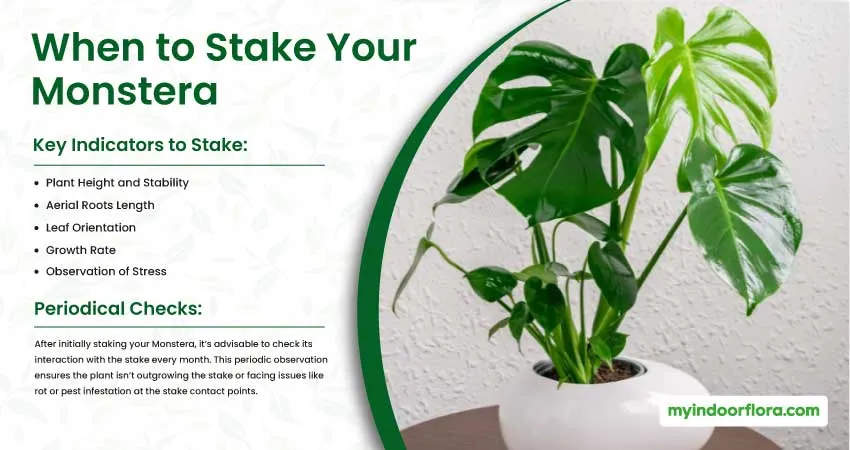
Periodical Checks:
After initially staking your Monstera, it’s advisable to check its interaction with the stake every month. This periodic observation ensures the plant isn’t outgrowing the stake or facing issues like rot or pest infestation at the stake contact points.
Staking Procedure Step-by-Step
Staking a Monstera isn’t just about pushing a stake into the pot. A methodical approach can ensure the plant’s health and growth aren’t compromised.
Step 1: Gather the Necessary Materials
- Stake of Choice: Moss pole, wooden stake, or any other preferred option.
- Ties: Soft ties, jute twine, or Velcro plant ties. Avoid wire or harsh materials.
- Gloves: To protect your hands during the process.
- Watering Can: To water the plant after staking.
Step 2: Position the Stake
Place the stake close to the plant’s main stem, ensuring it doesn’t damage the root system. It should be inserted deep enough into the soil to provide adequate support.
Step 3: Gently Attach the Plant
Using the ties, start attaching the Monstera to the stake. Begin at the base and work your way up. Ensure the ties are secure but not too tight – they shouldn’t constrict the plant’s growth.
Step 4: Monitor Aerial Roots
Aerial roots will seek the stake for support. Direct them towards the stake, and they’ll naturally wrap around it. For moss poles, misting can encourage the roots to grip the pole more effectively.
Step 5: Water the Plant
After the staking process, give your Monstera a thorough watering. It helps settle the soil around the newly inserted stake and provides the plant with hydration to combat any stress induced by the staking process.
Step 6: Position the Potted Plant Appropriately
Once staked, ensure the Monstera still receives adequate light, especially if the staking process involved any repositioning.
Step 7: Regular Maintenance
- Check the ties every couple of weeks to ensure they aren’t too tight.
- Rotate the pot every month for even growth, as Monsteras tend to grow towards the light.
- Observe the stake’s condition, especially if it’s biodegradable like wood or moss, to ensure it isn’t rotting.
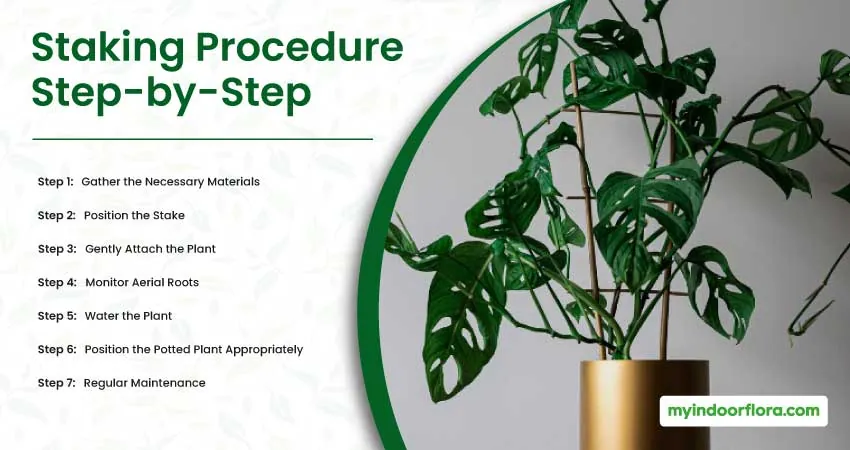
Tip: If using a moss pole, maintaining its humidity by regular misting can promote better adherence for the aerial roots and provide a favorable environment for the Monstera.
Caring for a Staked Monstera
A staked Monstera might have different care requirements than one left to sprawl freely. The introduction of the stake changes its growth direction and interaction with its environment.
Light and Positioning:
- Optimal Light: A staked Monstera will grow vertically, aiming to maximize its exposure to light. Ensure it receives indirect, bright light. Too much direct sunlight can burn its leaves.
- Rotate Regularly: Even with staking, it’s essential to rotate the plant every few weeks. This ensures all sides receive equal light and promotes uniform growth.
Watering and Humidity:
- Consistent Moisture: The presence of a stake, especially a moss pole, can change the pot’s moisture dynamics. Ensure the soil remains consistently moist but not soggy.
- Humidity Levels: If using a moss pole, maintain its humidity by regular misting. This not only benefits the aerial roots but also creates an ambient environment that Monsteras love.
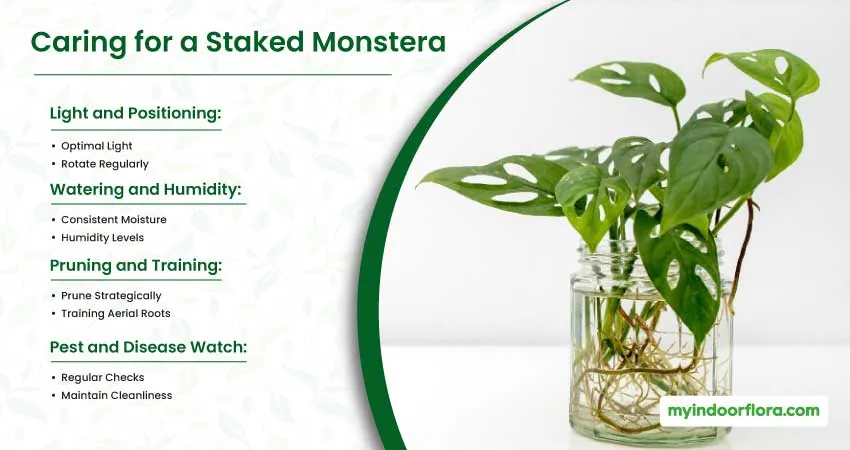
Pruning and Training:
- Prune Strategically: As your Monstera grows taller, consider pruning older or lower leaves. This ensures the plant’s energy is directed towards new growth and maintaining the leaves it needs most.
- Training Aerial Roots: Guide any new aerial roots towards the stake, ensuring they wrap around it. This aids in strengthening the bond between the plant and the stake.
Pest and Disease Watch:
- Regular Checks: The intersection of the Monstera and the stake can be a hotspot for pests or mold. Regularly inspect these areas.
- Maintain Cleanliness: Keep the stake, especially moss poles, clean. A bi-monthly gentle brush-down can prevent potential problems.
Common Mistakes to Avoid
Staking a Monstera might seem straightforward, but certain pitfalls can impede its growth or even harm it.
- Over-tightening Ties: This can restrict growth and potentially damage the stem.
- Improper Stake Depth: Not inserting the stake deep enough can result in inadequate support, risking the plant toppling over.
- Ignoring Aerial Roots: Not guiding these can result in them growing away from the stake or into undesirable areas.
- Not Checking for Rot: Especially with organic stakes like wood or moss poles. Rot can harm the plant and attract pests.
- Overwatering: While the plant might need more water post-staking, avoid making the soil soggy. It can lead to root rot.
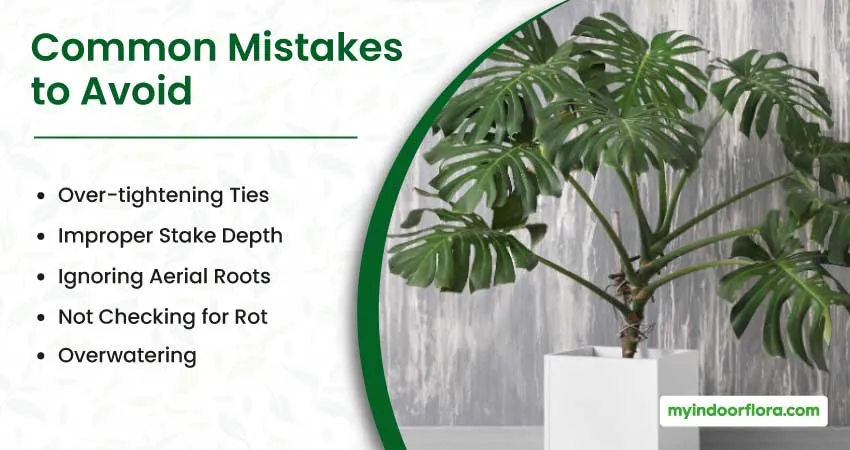
Alternatives to Traditional Staking
While staking is the most common method to support Monsteras, some innovative alternatives can be both functional and decorative.
Lattice Work:
A wooden or metal lattice can be a backdrop against which your Monstera climbs. It provides ample support and gives a garden-esque touch to your interiors.
Hanging Monstera:
Particularly suitable for smaller Monstera varieties, hanging pots allow the plant to grow downwards, providing a unique aesthetic.
Wall-mounted Ties:
If positioned next to a wall, consider using wall-mounted ties or hooks. They can guide the plant’s growth without a stake’s need, allowing it to spread across the wall.
Frame Support:
Think of it as a picture frame but for your Monstera. The plant grows within the frame, creating a living piece of art.
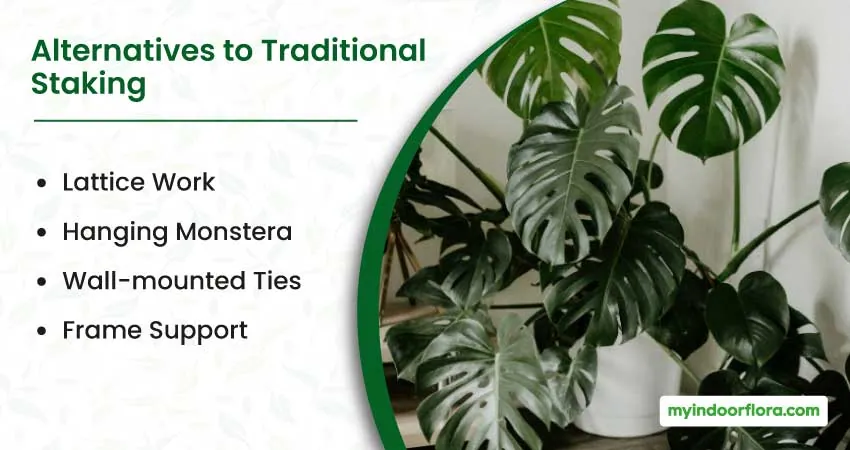
| Method | Aesthetic | Functionality | Cost | Space Efficiency |
|---|---|---|---|---|
| Traditional Staking | Medium | High | Med | Medium |
| Lattice Work | High | High | High | Low |
| Hanging Monstera | High | Medium | Med | High |
| Wall-mounted Ties | Medium | Medium | Low | High |
| Frame Support | Very High | Medium | High | Medium |
Each method has its pros and cons, and the choice often depends on the specific requirements of the plant owner and the Monstera’s environment.
Conclusion
Staking and supporting a Monstera is more than just an aesthetic choice—it’s a commitment to ensuring the plant’s optimal health and growth. From choosing the right time and method of staking, to caring for the plant post-staking and avoiding common pitfalls, every decision plays a role in its well-being.
While traditional staking remains a favorite, exploring alternatives can add a unique touch to your interior décor. Whatever method you choose, remember to prioritize your Monstera’s health, frequently check its condition, and adapt your care routine as it continues to thrive and flourish in its staked environment. Happy planting!

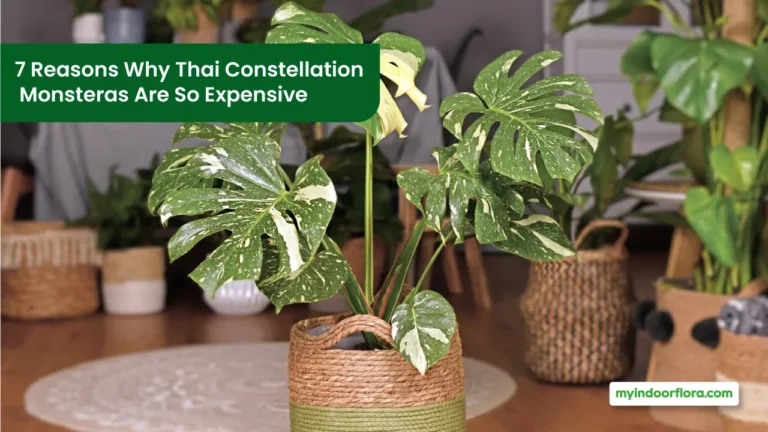
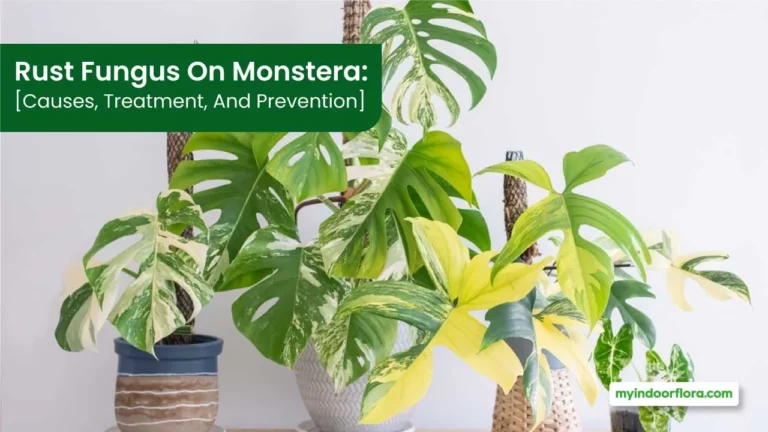
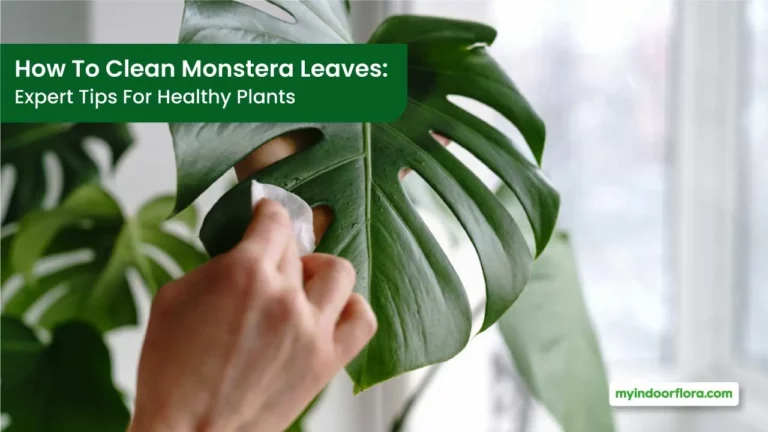
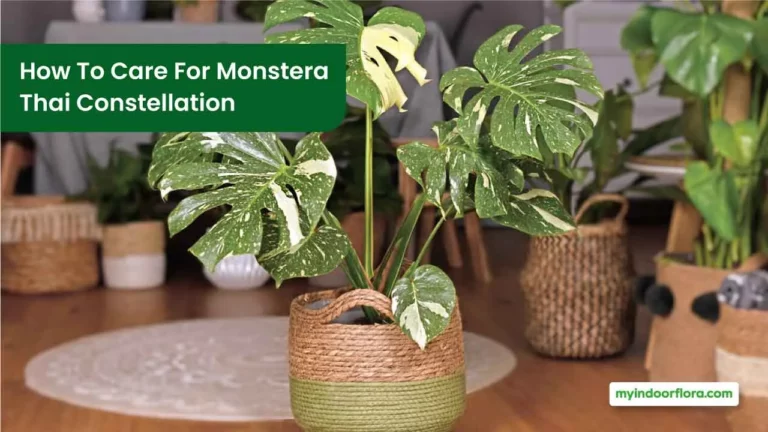
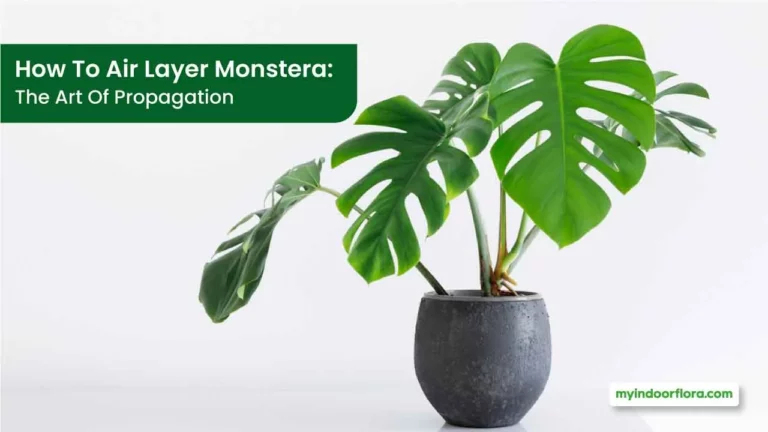
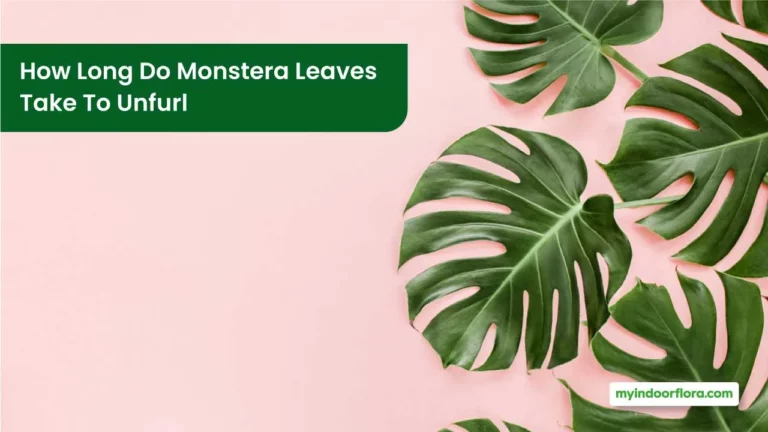
![Damaged Monstera Leaves [Quick Remedies & Prevention Tips]](https://myindoorflora.com/wp-content/uploads/2023/09/Damaged-Monstera-Leaves-Quick-Remedies-Prevention-Tips-768x432.webp)
